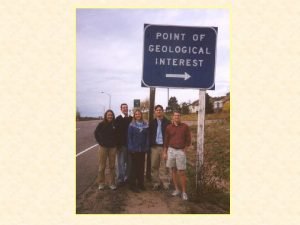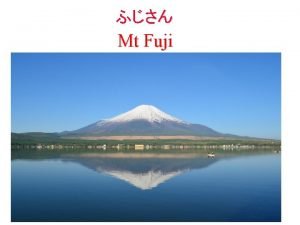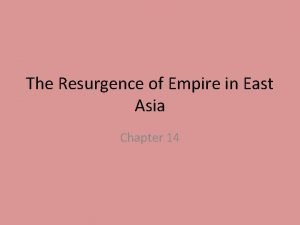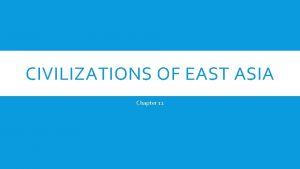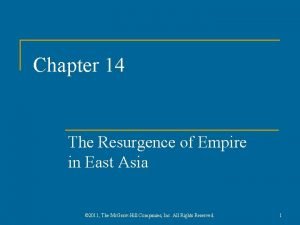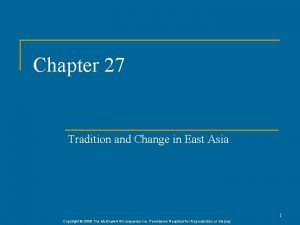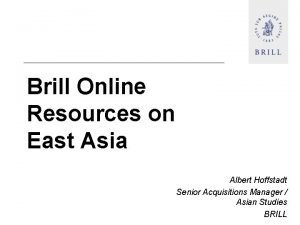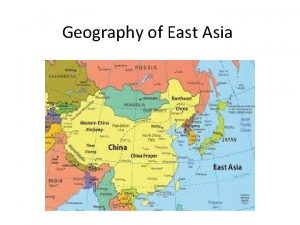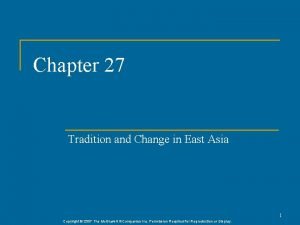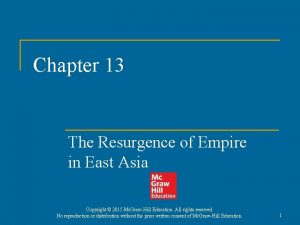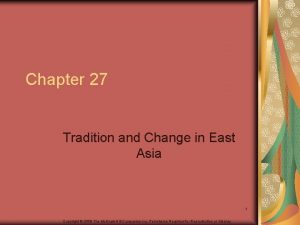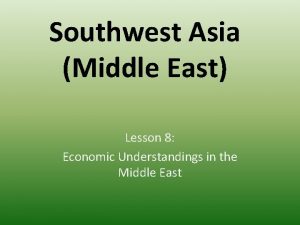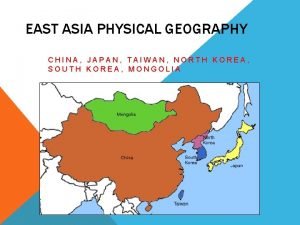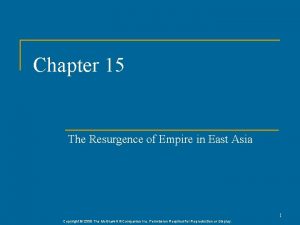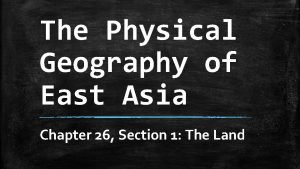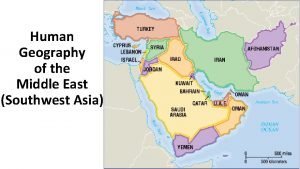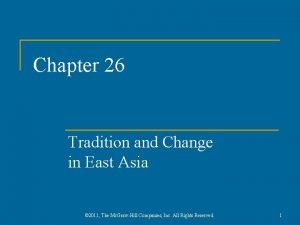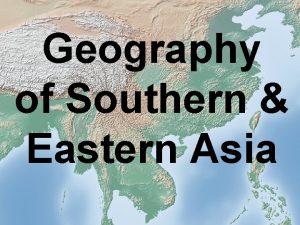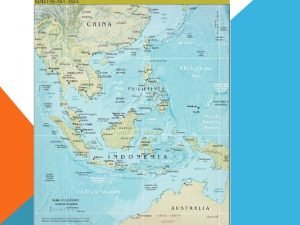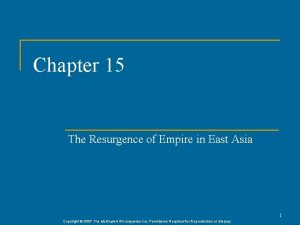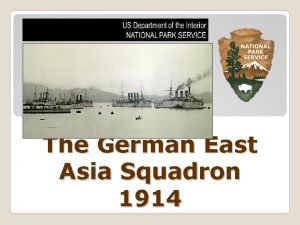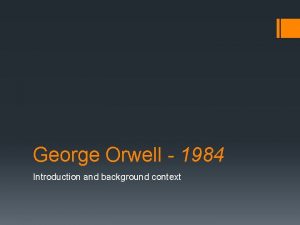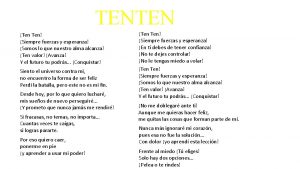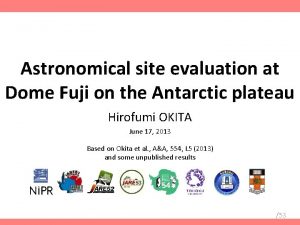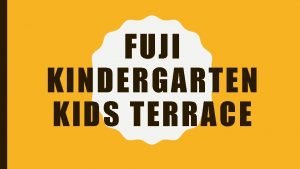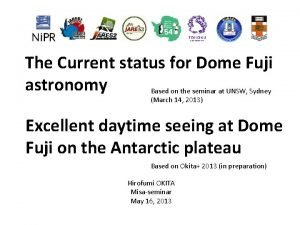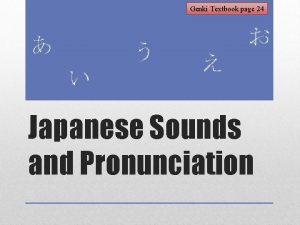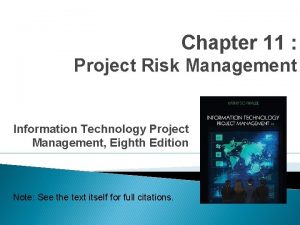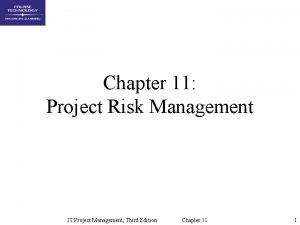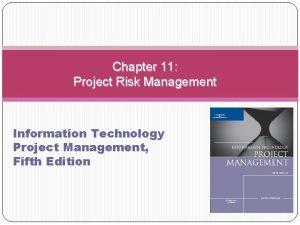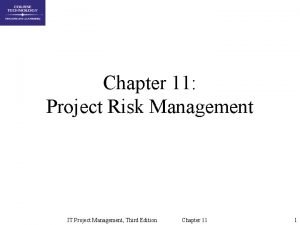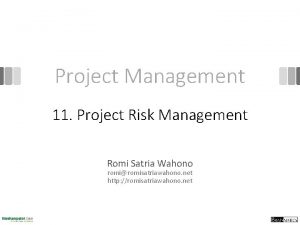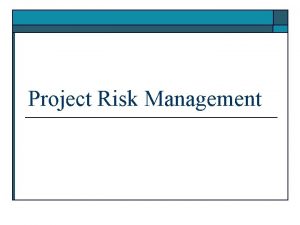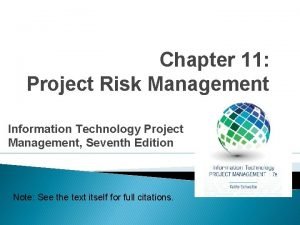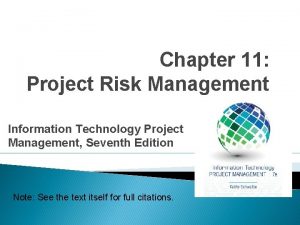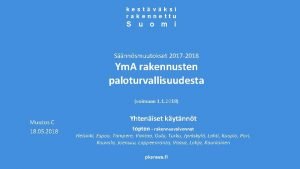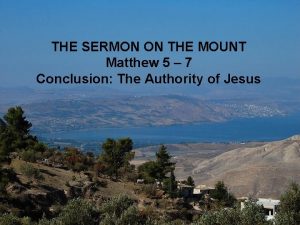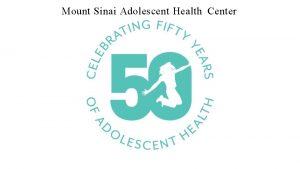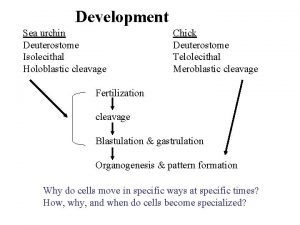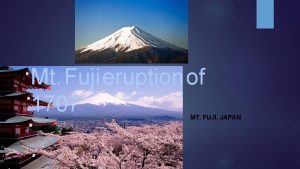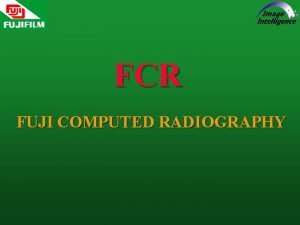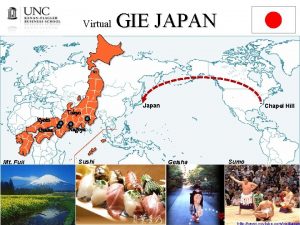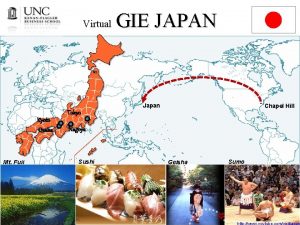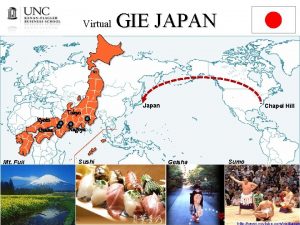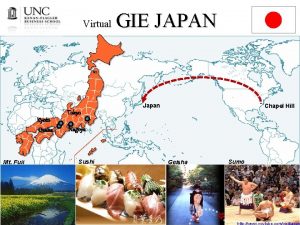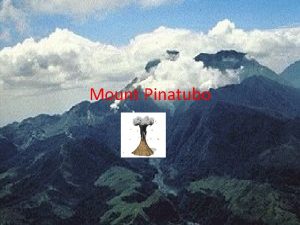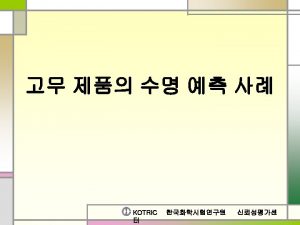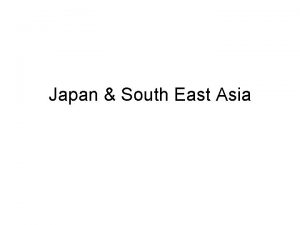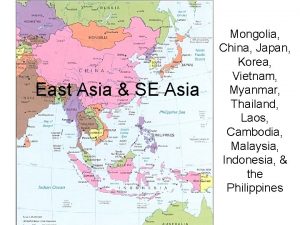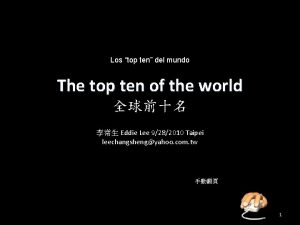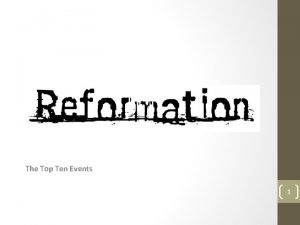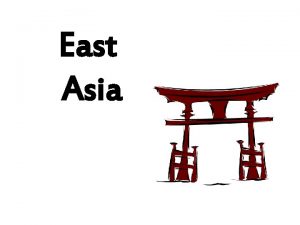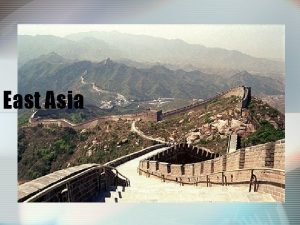East Asia TOP TEN 1 Mount Fuji Japan





























































- Slides: 61

East Asia TOP TEN

1. Mount Fuji Japan � Mount Fuji Volcanic – classified as active with a low risk of eruption � Surrounded by 5 lakes �

Mount Fuji

2. Gobi Desert � Stretches from northwest China into Mongolia � 500, 000 square miles � Larger than Texas & California combined � Prime area for finding dinosaur fossils

Gobi Desert

3. River Systems � � � Important for irrigation, hydroelectric power, & transportation Huang He (Yellow River) 3, 000 miles Empties into Yellow Sea Named from the yellow silt it carries Also called “China’s Sorrow” because of the terrible floods it has caused

Huang He or Yellow River

River Systems � Chang Jiang (Yangtze River) Longest river in all of Asia 3, 900 miles Major trade route Also causes flooding � Xi Jiang (West River) � �

Chang Jiang

Chang Jiang (Yangtze River)

4. Revolutions in China � � Chinese Empire came to an end in 1911 when a Nationalist revolution led by Dr. Sun Yat-sen overthrew the Manchu Dynasty 1927 – Chiang Kai-shek set up a Nationalist government, but his rival Communist Mao Zedong, gained huge support from peasants During WWII, Nationalists & the Communists successfully together resisted Japan At the end of the war, the 2 groups fought each other again

Dr. Sun Yat-sen

Chiang Kai-shek

Mao Zedong

Revolutions in China � � 1949 – the Communists set up the People’s Republic of China on the mainland The Nationalists fled to the island of Taiwan and set up the Republic of China

5. Japan (WWII) � � � By the early 20 th century Japan had become a major power and continued to expand their empire December 7, 1941 – surprise attack on U. S. naval base of Pearl Harbor in Hawaii Brought U. S. into WWII U. S. – dropped 2 atomic bombs on Hiroshima & Nagasaki Ended with Japan’s defeat & surrender in 1945

Japanese planes prepare to take off for the Pearl Harbor attack

USS Arizona burned for two days after being hit by a Japanese bomb. Parts of the ship were salvaged, but the wreck remains at the bottom of Pearl Harbor to this day.

President Franklin D. Roosevelt signed the Declaration of War against Japan on the day following the attack.

Nagasaki The Fat Man mushroom cloud resulting from the nuclear explosion over Nagasaki.

6. Korea � � � Cultural bridge between Japan and the mainland of Asia Kingdom of Silla ruled Korea as a unified state until 936 when it was overthrown by the Koryo Dynasty Military rulers took power in the late 1100 s, but were conquered by the Mongols

Korea � � � Peninsula Controlled by China & Japan throughout its history Japanese ruled Korea until they were defeated in WWII in 1945 Northern part was controlled by the Soviet Union Southern half supported by the U. S.

Korea – A Divided Peninsula � � 1950 – Korean troops from the North invaded South Korea starting the Korean War ended in 1953 with a treaty that divided the peninsula North Korea (Communist) South Korea (Democratic)

7. Population � 1. 5 billion people China – 1. 3 billion (Special Administrative Regions in China: Hong Kong - 6. 9 million, Macao - 500, 000) � Japan – 127 million � North Korea – 22. 9 million � South Korea – 48 million � Mongolia – 2. 6 million � Taiwan – 22. 7 million �

China - population � � � 1 out of 5 people in the world lives in China Most populated country in the world 94% belong to the Han ethnic group Mainly live in eastern & southern China The rest of the people belong to about 50 different ethnic groups Non-Chinese peoples live in the far north & west

Population Distribution CHINA � 90% of the population is crowded on only 1/6 ths of the land � Most live in the fertile valleys and plains of the Huang He, Chang Jiang, & Xi � In these areas, population density is more than 518 people per square mile � Population is scarcest in the west � 30% live in cities

Population Distribution CHINA � Impacts of 1 billion plus people Population may grow faster than the food supply � Government encourages smaller families � One-child per couple policy (people with are rewarded with better income, reduced taxes, or the chance to go to a good school) �

8. Largest Cities in the Region � � � � Beijing, China Shanghai, China Tokyo, Japan Osaka, Japan Nagoya, Japan Seoul, South Korea Taipei, Taiwan

Temple of Heaven in Beijing, China

The Forbidden City, home to the emperors of the Ming and Qing dynasties in Beijing

Shanghai, China

Tokyo, Japan

Umeda Sky Building in Osaka, Japan

Nagoya Castle in Nagoya, Japan

Seoul, South Korea

Chiang Kai-Shek Memorial Hall, Taipei, Taiwan

Taipei, Taiwan

9. Languages � � � Chinese has many dialects, most speak Mandarin Chinese Written language is based on ideograms, or pictorial characters, and each one carries a meaning To read a newspaper, need to know 2, 000 – 3, 000 characters To have a solid grasp of the language need to know 25, 000 characters Japanese & Korean languages are related

Chinese Calligraphy

10. Religion � � � Buddhism Shintoism Confucianism Taoism Christianity Islam

Buddhism � � Religion originated in India Grew into an important religion in China by the 300 s A. D. Influenced by Confucianism & Taoism Important ideas include rebirth & the end of the rebirth cycle

Shintoism � � � Native religion of Japan and was once its state religion A form of animism It involves the worship of kami, translated to mean "sacred spirits which take the form of things and concepts important to life, such as wind, rain, mountains, trees, rivers and fertility“

Shintoism � � After World War II, Shinto lost its status of state religion Some Shinto practices and teachings, once given a great deal of prominence during the war, are no longer taught nor practiced today, and others remain largely as everyday activities, like Japanese New Year, that few identify with religious connotations.

A torii, a traditional Japanese gate commonly found at the entry to a Shinto shrine The floating torii At low tide

Confucianism � � � Based on the teaching of Confucius A Chinese philosopher who lived from 551 -479 B. C. Believed in respect for the past & one’s ancestors � Children should obey parents � Parents should obey government & emperor � Stressed the importance of education

Confucius

Taoism � � Based on the teachings of Lao-tzu (6 th century B. C. ) Believed in the importance of preserving & restoring harmony in the individual & universe Thought governments should leave the people alone & do as little as possible Individual should seek harmony with nature


Religion � Communist governments in China & North Korea have discouraged religious practices, but many people have held to their beliefs

Miscellaneous Pictures

Plateau of Tibet

Tokyo Fish Market

Rice fields in China

Sapporo, Japan

Nagoya, Japan

Yokohama, Japan

Tokyo, Japan

Osaka, Japan

Great Wall of China

New Year’s celebration in Hong Kong

Hong Kong
 Romanche trench
Romanche trench Fuji
Fuji Chartch
Chartch Chapter 14 the resurgence of empire in east asia
Chapter 14 the resurgence of empire in east asia Guided reading activity civilizations of east asia
Guided reading activity civilizations of east asia Post classical vietnam
Post classical vietnam Chapter 14 the resurgence of empire in east asia
Chapter 14 the resurgence of empire in east asia Chapter 27 tradition and change in east asia
Chapter 27 tradition and change in east asia East asia
East asia Physical geography of east asia
Physical geography of east asia Chapter 27 tradition and change in east asia
Chapter 27 tradition and change in east asia Chapter 27 section 1 landforms and resources
Chapter 27 section 1 landforms and resources Chapter 13 the resurgence of empire in east asia
Chapter 13 the resurgence of empire in east asia Chapter 27 tradition and change in east asia
Chapter 27 tradition and change in east asia Lesson 8 middle east and south asia
Lesson 8 middle east and south asia Physical geography east asia
Physical geography east asia Chapter 15 the resurgence of empire in east asia
Chapter 15 the resurgence of empire in east asia Physical geography of east asia
Physical geography of east asia East asia & sushi
East asia & sushi Southwest asia geography
Southwest asia geography Chapter 26 tradition and change in east asia
Chapter 26 tradition and change in east asia East asia physical map
East asia physical map Climate regions in east asia
Climate regions in east asia Chapter 15 the resurgence of empire in east asia
Chapter 15 the resurgence of empire in east asia German east asia squadron
German east asia squadron Easc usc
Easc usc Oceania eurasia east asia map
Oceania eurasia east asia map Ten twenty thirty
Ten twenty thirty Ten ten siempre fuerzas y esperanza
Ten ten siempre fuerzas y esperanza Ten ten program
Ten ten program Winds that blow over short distances are called
Winds that blow over short distances are called North american
North american East is east and west is west
East is east and west is west Dome fuji station
Dome fuji station Regular preterite endings
Regular preterite endings Fuji 3200
Fuji 3200 Fuji xerox
Fuji xerox Takaharu tezuka kindergarten
Takaharu tezuka kindergarten Dome fuji
Dome fuji Genki pronunciation
Genki pronunciation Top ten risk item tracking
Top ten risk item tracking Top ten risk item tracking
Top ten risk item tracking Expected monetary value
Expected monetary value Figure 11-4
Figure 11-4 Top ten tips
Top ten tips Top ten risk item tracking
Top ten risk item tracking Top 10 owasp 2013
Top 10 owasp 2013 Mobile owasp top 10
Mobile owasp top 10 Top ten risk item tracking
Top ten risk item tracking Top ten risk item tracking
Top ten risk item tracking Owasp top ten 2016
Owasp top ten 2016 Top ten mathematics
Top ten mathematics Elasmobranchology
Elasmobranchology Top ten risk item tracking
Top ten risk item tracking Top ten risk item tracking
Top ten risk item tracking The ten sins
The ten sins Paloasetus
Paloasetus Owasp
Owasp Summary of the sermon on the mount matthew 5-7
Summary of the sermon on the mount matthew 5-7 Mount sinai adolescent clinic
Mount sinai adolescent clinic Civilization
Civilization 33 hour chick embryo
33 hour chick embryo
